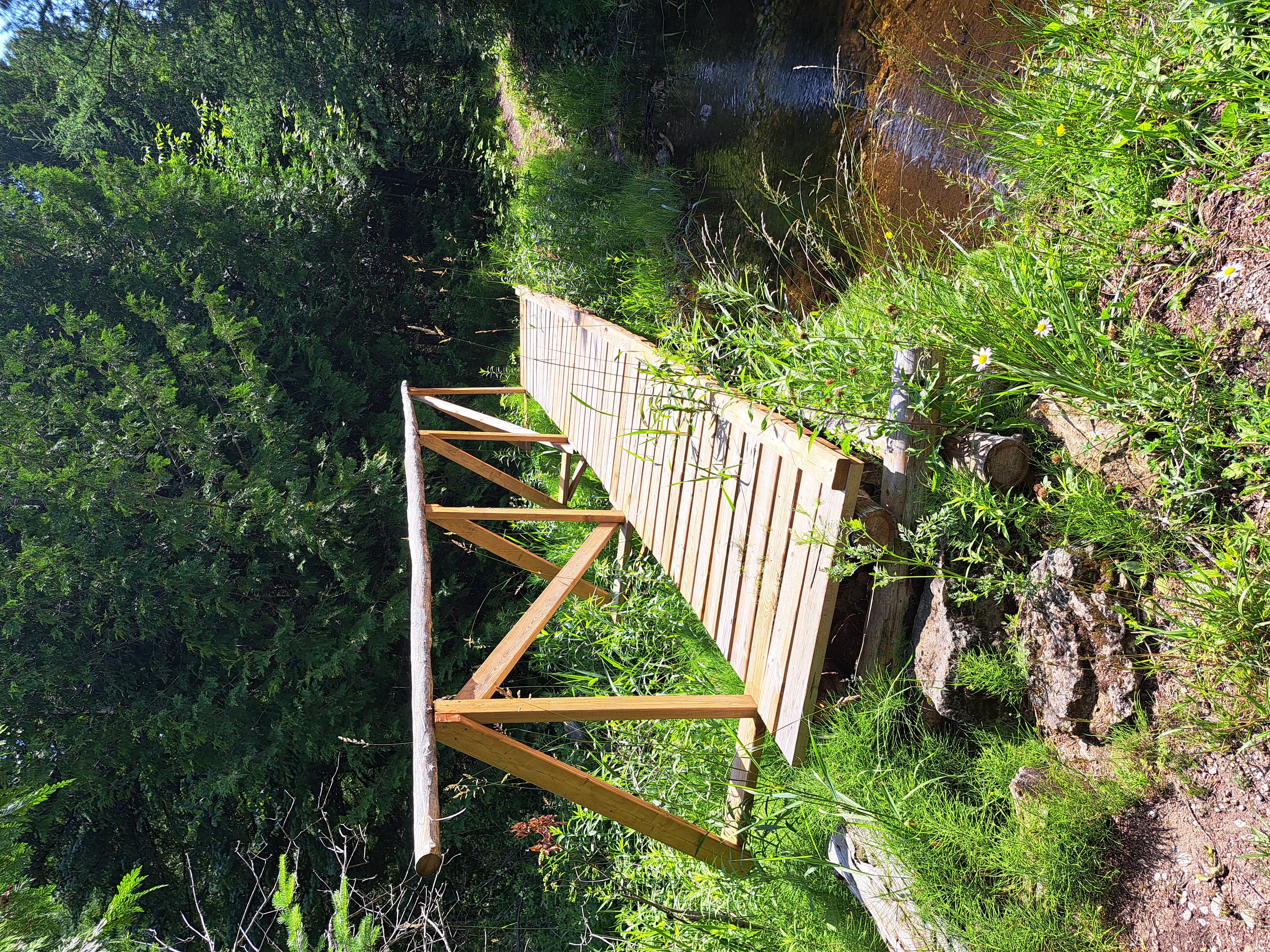|
- Home
- Trails
- Year of the Bridges
- RLT Sec 6 Bridges
Radial Line Trail, Section 6 Bridges
By Liam Waterman, GHTC Volunteer

See more photos here!
There are two bridges located on section 6 of the Guelph Hiking Trail Club (GHTC)’s Radial Line Trail (RLT), both of which can be found on the short portion of this section that follows the bed of the former Radial Line, near Blue Springs Creek.1 The larger of these two bridges crosses the creek in question, while the smaller spans a low-lying spillover area frequently prone to seasonal flooding. The presence of these bridges in their current state is owed to a number of work parties organized in the fall of 2021 by section leader Bob Fanning and a group of GHTC volunteers, who together rebuilt the bridge over Blue Springs Creek and updated the seasonal bridge with decking boards.2 This work has been particularly important for the safety of recreational users of this section of trail, preventing slippery or otherwise treacherous conditions.
This section of trail has always required connective structures, being historically prone to occasional flooding due to its proximity to the creek. The bridges at the current locations were initially installed in 2008, at the initiative of then section leader Mary Langevin Irwin.3 Former trail coordinator Phil Kidston actually had proposed the installation of these bridges as far back as 2005, but had been delayed in part by negotiations with Blue Springs Golf Course, which had raised objections to the construction of any “major structures” on the trail.4 In the end, the golf course gave permission for an informal walkover at the creek, which could utilize felled cedar logs. The two bridges, as a result, both took the form of two cedar logs laid together lengthwise, with cedar supports at either end. Though rudimentary, these bridges were sufficient for the needs of the trail at the time, which was not as wet as it is today. The bridge over the spillover area in particular was rarely used, since a small detour on lower ground around it was usually easily traversable.
Unfortunately, conditions on the trail were soon to worsen during the 2010s, as a nearby beaver dam began to increase the volume of water collected in the section of Blue Springs Creek surrounding this portion of the RLT. This led to flooding on the trail, which was at its worst during the spring. Bob Fanning, now section leader, recalls worrying that the trail might be lost entirely if the water level continued to rise. Though it remains accessible, the trail is now reliant on the presence of these bridges. The rudimentary design of the bridges became a concern at this point, since slippery conditions caused by increased water levels could make the absence of decking boards somewhat dangerous. Sandra Morrill, who took over as section leader in 2012, organized work parties to add handrails, which were again made with local cedar. This alleviated the problem somewhat, making the bridges safe enough for continued use. Nonetheless, it was clear that the bridges would need to be upgraded at some point down the line.
In 2021 current RLT #6 section leader Bob Fanning and the rest of the GHTC agreed that it was time to replace these log bridges on section 6. The bridge over the creek in particular, which was made with much longer and thinner logs than the bridge over the spillway, was beginning to show significant signs of decay.5 Work parties were planned for the fall of that year. After inspecting the bridges, it was decided that the bridge over the spillway was still structurally secure, and only needed to have new decking boards added on top of the original cedar logs. The bridge over the creek, by contrast, needed to be replaced entirely. The new design for this bridge would implement cedar cribs, which were made from boxes of stripped logs filled with rocks. These cribs would elevate the bridge, keeping it safe from future flooding and hopefully increasing its lifespan. The new bridge would also possess a handrail, again made from cedar logs, supported by a number of trusses made from cedar planks. RLT section #3 leader Jim Hoare, whose carpentry experience includes extensive work with the Guelph Little Theatre, was largely responsible for the design work. The crib design in particular resembles that used for the Cove Valley Bridge on section 3 of the RLT, which Jim Hoare worked on. The cribs for that bridge were designed by Phil Kidston, with inspiration from the bridge building techniques of the Caledon Bruce Trail Club.
The work on the new bridge proceeded in three separate stages. The first stage entailed the construction of the cribs, which were placed alongside the original bridge. The second stage entailed laying new cedar logs across these cribs, and then adding the decking boards. While much of the material for this project was sourced from the surrounding area, decking boards still needed to be brought in from outside. Due to the treacherous and rocky nature of RLT #6, taking these building materials in via the trail itself would have been extremely difficult. Luckily, GHTC volunteers were able to negotiate with the landowner to access the trail by way of the former rail bed, which had been kept clear for logging purposes. A friend of the landowner who happened to be present on the day of the work party actually assisted with his ATV, making the bridge-building process significantly easier. The nearby Blue Springs scout camp also generously allowed GHTC to use their parking lot as a staging area, despite the fact that the camp itself was closed due to the COVID-19 pandemic. Thanks to the assistance of these actors, the second stage of construction went off smoothly.
The final stage of bridge construction entailed the removal of the original bridge and the addition of the new handrail. Once these changes were made, and decking boards were added to the second bridge, work on the section #6 bridges was deemed complete. The reconstruction of these bridges has helped to keep this section safe and ensure that it remains accessible to the public for recreational use.
Notes
1. Much of the information in this article was garnered from an in person interview with RLT #6 section leader Bob Fanning. Many thanks to him for his assistance.
2. “Radial Line Trail - Section 6 bridge upgrades”, Guelph Hiking Trail Club, https://guelphhiking.com/RLT-section-6-bridges-upgrade.
3. “Minutes of the Annual General Meeting: November 20, 2008”, Minutes, Newsletters, Handbooks, Posters, Scrapbooks, Correspondence and Other Items Relating to the Guelph Hiking Trail Club, 1970-, McLaughlin Library, University of Guelph.
4. Executive Meeting: Minutes of April 7, 2008”, Minutes, Newsletters, Handbooks, Posters, Scrapbooks, Correspondence and Other Items Relating to the Guelph Hiking Trail Club, 1970-, McLaughlin Library, University of Guelph.
5. “Radial Line Trail - Section 6 bridge upgrades”, Guelph Hiking Trail Club, https://guelphhiking.com/RLT-section-6-bridges-upgrade.


